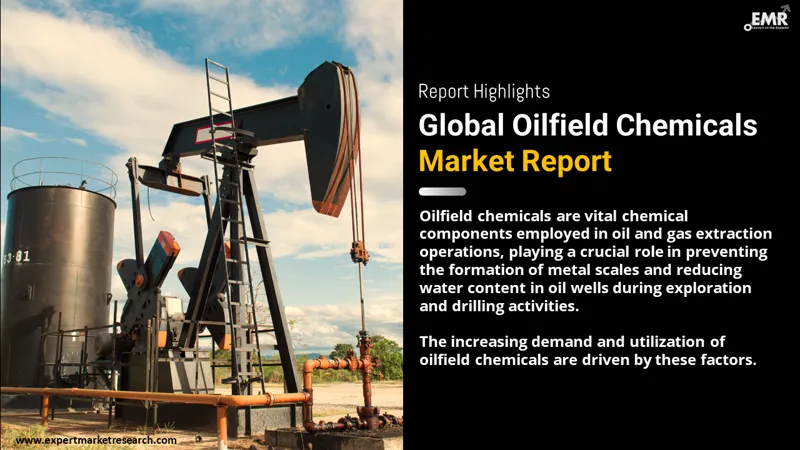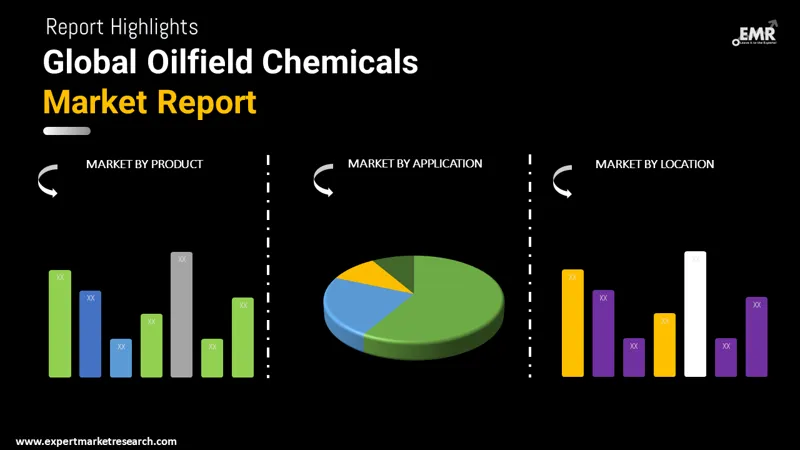
Consumer Insights
Uncover trends and behaviors shaping consumer choices today
Procurement Insights
Optimize your sourcing strategy with key market data
Industry Stats
Stay ahead with the latest trends and market analysis.
The global oilfield chemicals market attained a value of USD 29.26 Billion in 2025. The market is further expected to grow in the forecast period of 2026-2035 at a CAGR of 4.40% to reach USD 45.01 Billion by 2035.
Base Year
Historical Period
Forecast Period
Compound Annual Growth Rate
4.4%
Value in USD Billion
2026-2035
*this image is indicative*
| Global Oilfield Chemicals Market Report Summary | Description | Value |
| Base Year | USD Billion | 2025 |
| Historical Period | USD Billion | 2019-2025 |
| Forecast Period | USD Billion | 2026-2035 |
| Market Size 2025 | USD Billion | 29.26 |
| Market Size 2035 | USD Billion | 45.01 |
| CAGR 2019-2025 | Percentage | XX% |
| CAGR 2026-2035 | Percentage | 4.40% |
| CAGR 2026-2035 - Market by Region | Asia Pacific | 5.1% |
| CAGR 2026-2035 - Market by Country | India | 5.8% |
| CAGR 2026-2035 - Market by Country | China | 4.9% |
| CAGR 2026-2035 - Market by Application | Production | 4.8% |
| CAGR 2026-2035 - Market by Location | Offshore | 5.3% |
| Market Share by Country 2025 | India | 3.6% |
Based on product, the demulsifiers segment is expected to provide significant opportunities for the market expansion in the coming years. This can be associated with the increased demand for demulsifiers in the process of separating oil and water at the oilfields. In addition, demulsifiers also reduce the corrosion of pipes, thus, reducing the overall equipment maintenance cost. These factors are anticipated to aid the market growth in the coming years.

Read more about this report - REQUEST FREE SAMPLE COPY IN PDF
Region-wise, North America is expected to occupy a significant share in the oilfield chemicals industry. Within North America, the United States is likely to be a major market for oilfield chemicals. The increase in drilling activities in the region is driving the demand for oilfield chemicals. The increased exploration activities and a steady expansion of shale oil and gas drilling have been contributing to the market growth.

Read more about this report - REQUEST FREE SAMPLE COPY IN PDF
Oilfield chemicals are chemical components that are utilised in oil and gas extraction operations. These components block the arrangement of metal scales and reduce the water content in the oil well during exploration and drilling activities, which is leading to a rise in demand for and increased utilisation of oilfield chemicals.
By product, the market can be distributed into:
The market can be broadly categorised, on the basis of application, into:
On the basis of location, the market can be segmented into:
The regional markets for the product include:
| CAGR 2026-2035 - Market by | Country |
| India | 5.8% |
| China | 4.9% |
| UK | 4.0% |
| USA | 3.9% |
| Italy | 3.1% |
| Canada | XX% |
| Germany | XX% |
| France | XX% |
| Japan | 3.0% |
| Australia | XX% |
| Saudi Arabia | XX% |
| Brazil | XX% |
| Mexico | XX% |
The market for oilfield chemicals is anticipated to witness a significant growth due to a growth in oil and gas exploration activities across the world, as a result of the increasing energy demands globally. The increase in drilling activities, such as deep-water and ultra deep-water drilling activities, is estimated to aid the oilfield chemical industry in the coming years. This can be attributed to the rapid drying up of oil fields, as a result of which the major energy companies are aiming to extract oil and gas trapped beneath more challenging and deeper basins. Moreover, the emergence of eco-friendly oilfield chemicals is expected to augment the market growth in the forecast period.
The report presents a detailed analysis of the following key players in the global oilfield chemicals market, looking into their capacity, market shares, and latest developments like capacity expansions, plant turnarounds, and mergers and acquisitions:
The comprehensive report looks into the macro and micro aspects of the industry. The EMR report gives an in-depth insight into the market by providing a SWOT analysis as well as an analysis of Porter’s Five Forces model.




*While we strive to always give you current and accurate information, the numbers depicted on the website are indicative and may differ from the actual numbers in the main report. At Expert Market Research, we aim to bring you the latest insights and trends in the market. Using our analyses and forecasts, stakeholders can understand the market dynamics, navigate challenges, and capitalize on opportunities to make data-driven strategic decisions.*
Get in touch with us for a customized solution tailored to your unique requirements and save upto 35%!
In 2025, the global oilfield chemicals market attained a value of nearly USD 29.26 Billion.
The market is projected to grow at a CAGR of 4.40% between 2026 and 2035.
The major market drivers include the emergence of eco-friendly oilfield chemicals, increasing demand for oilfield supplements, and the surging demand for demulsifiers.
The growing oil and gas exploration activities and the increasing drilling activities are the key trends guiding the market growth.
The different products available in the market are inhibitors, demulsifiers, rheology modifiers, friction reducers, biocides, surfactants, and foamers, among others.
Drilling, production, cementing, and workover and completion are the major applications of oilfield chemicals.
The significant locations considered within the market report are onshore and offshore.
The major regions in the market are North America, Latin America, the Middle East and Africa, Europe, and the Asia Pacific.
The major players in the market are Halliburton Company, Kraton Corporation, Solvay SA, BASF SE, Clariant International Ltd., and NuGenTec LLC, among others.
The market is estimated to witness a healthy growth in the forecast period of 2026-2035 to reach USD 45.01 Billion by 2035.
Explore our key highlights of the report and gain a concise overview of key findings, trends, and actionable insights that will empower your strategic decisions.
| REPORT FEATURES | DETAILS |
| Base Year | 2025 |
| Historical Period | 2019-2025 |
| Forecast Period | 2026-2035 |
| Scope of the Report |
Historical and Forecast Trends, Industry Drivers and Constraints, Historical and Forecast Market Analysis by Segment:
|
| Breakup by Product |
|
| Breakup by Application |
|
| Breakup by Location |
|
| Breakup by Region |
|
| Market Dynamics |
|
| Competitive Landscape |
|
| Companies Covered |
|
| Report Price and Purchase Option | Explore our purchase options that are best suited to your resources and industry needs. |
| Delivery Format | Delivered as an attached PDF and Excel through email, with an option of receiving an editable PPT, according to the purchase option. |
Single User License
One User
USD 3,999
USD 3,599
tax inclusive*
Datasheet
One User
USD 2,499
USD 2,249
tax inclusive*
Five User License
Five User
USD 4,999
USD 4,249
tax inclusive*
Corporate License
Unlimited Users
USD 5,999
USD 5,099
tax inclusive*
*Please note that the prices mentioned below are starting prices for each bundle type. Kindly contact our team for further details.*
Flash Bundle
Small Business Bundle
Growth Bundle
Enterprise Bundle
*Please note that the prices mentioned below are starting prices for each bundle type. Kindly contact our team for further details.*
Flash Bundle
Number of Reports: 3
20%
tax inclusive*
Small Business Bundle
Number of Reports: 5
25%
tax inclusive*
Growth Bundle
Number of Reports: 8
30%
tax inclusive*
Enterprise Bundle
Number of Reports: 10
35%
tax inclusive*
How To Order

Select License Type
Choose the right license for your needs and access rights.

Click on ‘Buy Now’
Add the report to your cart with one click and proceed to register.

Select Mode of Payment
Choose a payment option for a secure checkout. You will be redirected accordingly.
Gain insights to stay ahead and seize opportunities.

Get insights & trends for a competitive edge.

Track prices with detailed trend reports.

Analyse trade data for supply chain insights.

Leverage cost reports for smart savings

Enhance supply chain with partnerships.

Connect For More Information
Our expert team of analysts will offer full support and resolve any queries regarding the report, before and after the purchase.
Our expert team of analysts will offer full support and resolve any queries regarding the report, before and after the purchase.
We employ meticulous research methods, blending advanced analytics and expert insights to deliver accurate, actionable industry intelligence, staying ahead of competitors.
Our skilled analysts offer unparalleled competitive advantage with detailed insights on current and emerging markets, ensuring your strategic edge.
We offer an in-depth yet simplified presentation of industry insights and analysis to meet your specific requirements effectively.
Share